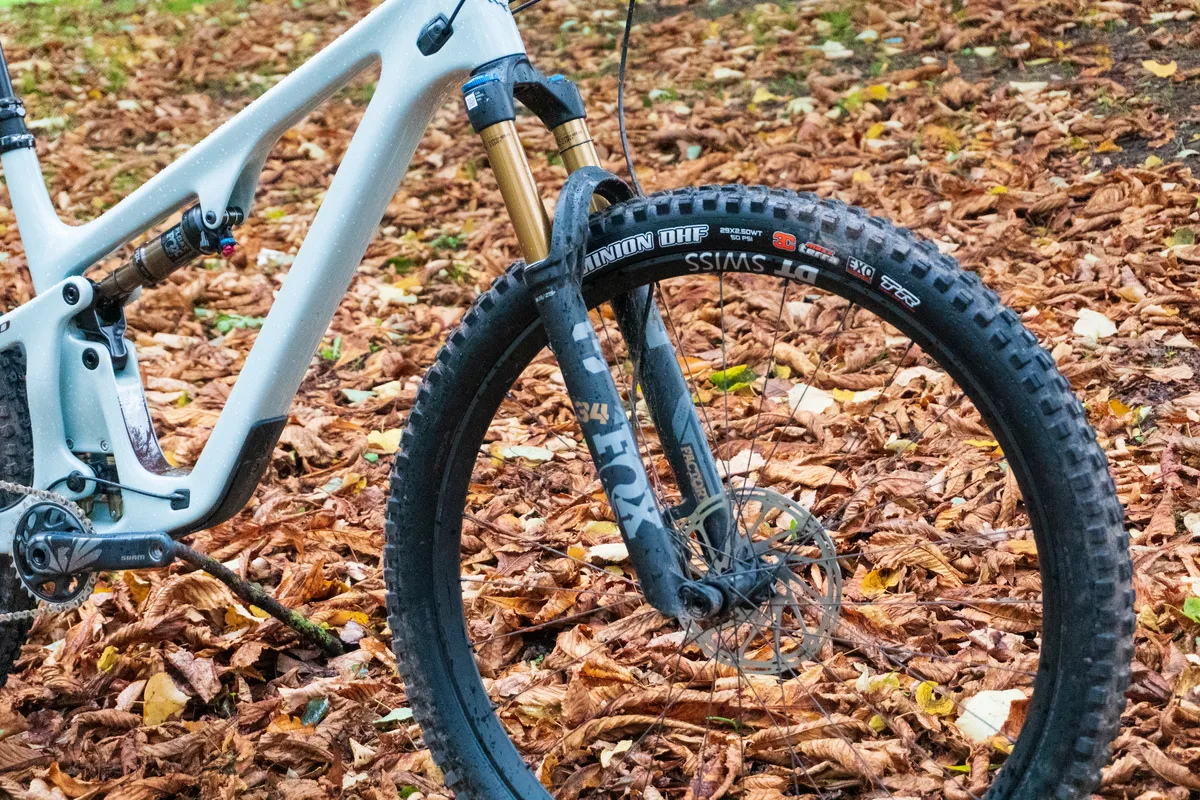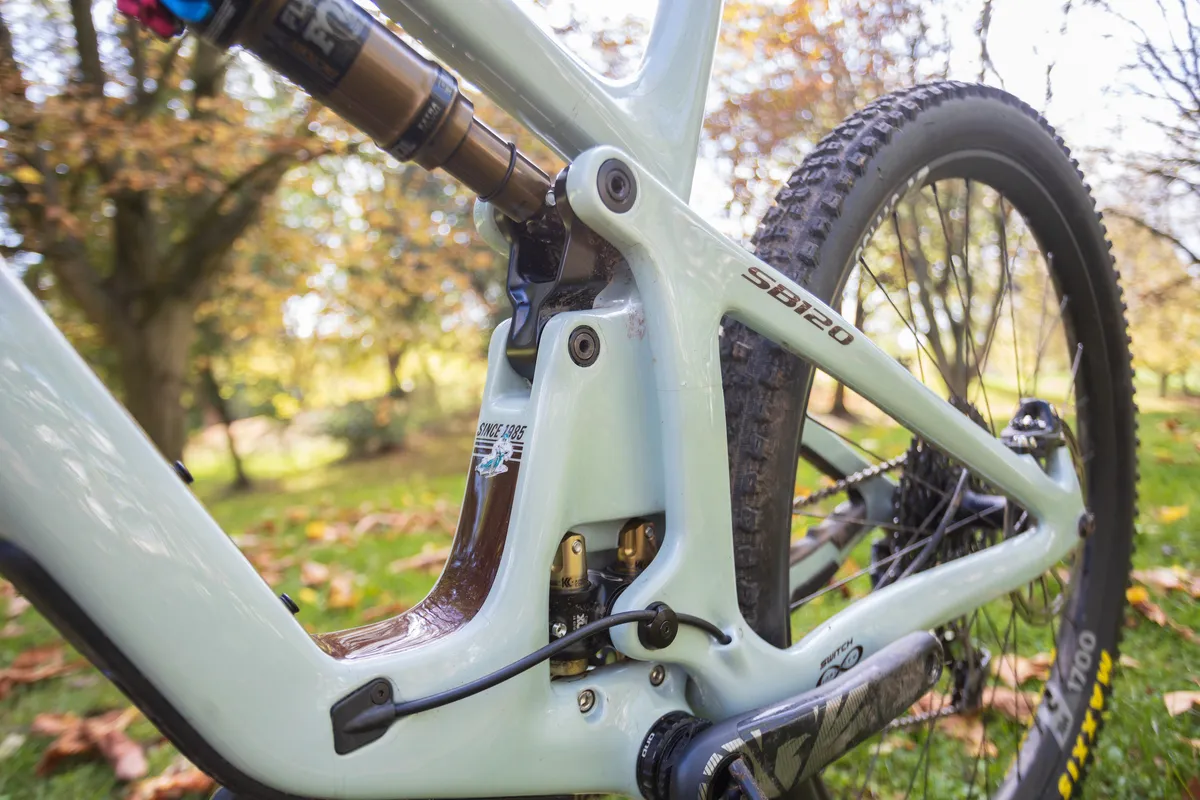Yeti has launched the new SB120, a 120mm-travel trail bike, featuring the revised Switch Infinity suspension link seen recently on the new SB160.
Though similar in frame travel to the outgoing SB115, this bike isn't designed for cross-country or downcountry adventures. It features 130mm of fork travel, four-piston brakes and (moderately) chunky rubber.
The key updates on the new bike come in the form of revised geometry, with Yeti following the curve of longer front ends, slacker head angles and size-specific chainstay lengths.
The brand has also rotated its unique, Fox-built Switch Infinity link by 90 degrees, changing the architecture of the bike.
Yeti SB120 geometry details

Yeti recognised that in recent years bikes have been growing and slackening. The SB115, for example, was fairly short in its reach when it was launched in 2020.
Yeti says its engineers have focused on bringing the new bikes a more 'balanced' ride, both via the geometry and by giving the front of the bike more travel.
The additional front travel is provided because of the slacker head angles the bike now features. Slacker angles naturally drop the front end for a given fork length and so, by adding travel, Yeti claims the bikes have this improved balance. The head tube sits at 66.5 degrees.
Reach figures have grown when compared to the SB115. The size-large SB120 has a 475mm reach, while the SB115 has a 450mm reach. Yeti says this improves the bike's agility, thanks to riders having a more neutral position on the bike, which better weights both wheels.

Yeti has also altered both the seat tube angle and the chainstay length, depending on the size of the bikes.
The seat tubes get steeper on larger bikes, with Yeti claiming this makes the transition from seated to standing easier for taller riders.
Seat tube angles range from 71.1 degrees to 73.2 degrees. However, the effective seat tube angle (the angle from the bottom bracket to the centre of the saddle rails, and that which you feel on the bike) is a constant 76.5 degrees.
The steeper seat tube angle therefore accounts for the additional saddle height a taller rider will have.
Furthermore, the chainstay lengths increase with bike size. They range from 433mm to 443mm. This has been done to maintain proportionality of geometry across bike sizes.
Yeti is offering the SB120 in six sizes, from XS to XXL.
| | XS | S | M | L | XL | XXL |
|---|---|---|---|---|---|---|
| Seat tube length (mm) | 345 | 365 | 400 | 440 | 470 | 485 |
| Effective top tube length (mm) | 540 | 571 | 603 | 625 | 652 | 672 |
| Head tube angle (degrees) | 66.5 | 66.5 | 66.5 | 66.5 | 66.5 | 66.5 |
| Effective seat tube angle (degrees) | 76.5 | 76.5 | 76.5 | 76.5 | 76.5 | 76.5 |
| Actual seat tube angle (degrees) | 71.1 | 71.5 | 71.9 | 72.3 | 72.7 | 73.2 |
| Chainstay length (mm) | 433 | 435 | 437 | 439 | 441 | 443 |
| Wheelbase (mm) | 1,122 | 1,157 | 1,191 | 1,217 | 1,249 | 1,274 |
| Estimated BB height (mm) | 335 | 335 | 335 | 335 | 335 | 335 |
| Standover (mm) | 699 | 709 | 714 | 718 | 720 | 725 |
| Head tube length (mm) | 92 | 98 | 104 | 115 | 126 | 147 |
| Stack (mm) | 604 | 610 | 615 | 625 | 635 | 655 |
| Reach (mm) | 395 | 425 | 455 | 475 | 500 | 515 |
| Front center (mm) | 689 | 722 | 754 | 778 | 808 | 831 |
Yeti SB120 suspension details

Yeti has tweaked the design of its Switch Infinity suspension linkage.
The system works by placing the rear pivot on a shuttle, built for Yeti by Fox and featuring Kashima-coated stanchions. It moves up and then down through the bike's suspension compression.
The idea is this separates the anti-squat (the force that counteracts pedal bob) from the shock's leverage curve, leading to an efficiently pedalling bike with fewer of the associated negatives of harsh suspension or pedal kickback.

The shuttle features a grease port to keep it running smoothly, and has a lifetime warranty, which is transferred to any owner of the bike.
Yeti has given the SB120 an 11 per cent progression rate, with the leverage rate going from 2.84 at the start of its travel to 2.52 at the end.
Yeti also says it has custom tuned each shock to the bike, in-house.
Turq-series bikes receive a linkage with updated hardware, including bearings and seals, to improve durability.

Yeti SB120 frame details

Other than the new shape and revisions to the Switch Infinity, there are more subtle changes to the bike, echoing the recently launched SB160.
There's a less pronounced belly kink at the bottom of the bike, meaning better ground clearance, while the chainstays sit a touch higher above the ground.
The Switch Infinity link and shock are held tighter in the frame, meaning there's more room for a bottle, and the seat tube is shorter, while still allowing longer-drop droppers.
Overall frame stiffness has been increased, without compromising compliance according to Yeti, while tyre clearance is improved.
The linkage that drives the shock has also seen work.
It's more compact, to help reduce overall frame standover heights, while it's also stiffer.
Standard-sized Enduro Max bearings are all held in the link, rather than in the front or rear carbon triangles, held securely by floating collet axles. Yeti says this system reduces tolerance gaps to virtually zero, while ensuring the assembly remains tight.
Yeti SB120 frame finishing touches

Plenty of thought has evidently gone into the bike's finishing touches. Cables are routed through internal tubes in the rear portion of the bike, while clamped stops at the head tube and by the bottom bracket ensure internal rattles are minimised. The down tube protection can be removed to aid cable installation.

The down tube protection is a two-piece item. It's as wide as the frame's carbon tube, with an inner rubberised layer and an outer hard plastic layer that can be replaced.
There's a threaded bottom bracket shell and ISCG05 mounts. These alloy inserts are co-moulded into the frame, rather than bonded in, during the frame's layup. SRAM's Universal Derailleur Hanger is included, so replacements should be available at virtually any bike shop.
Yeti SB120 build options

Five models will be available, as well a ($4,300) frame-only option. Three builds will feature the top-spec, higher-modulus Turq-series carbon, while there will be two 'C-Series' frames.
All bikes will have Fox 34 forks with 130mm travel and Float DPS shocks. They all come with four-piston brakes and 180mm rotors front and rear.
Yeti SB120 T1
- Fork: Fox 34 Factory GRIP2 130mm
- Shock: Fox Float DPS Factory
- Drivetrain: SRAM GX Eagle
- Brakes: SRAM G2 RSC
- Wheels: DT Swiss XM 1700
- Tyres: Maxxis Minion DHF EXO 2.5in (f), Maxxis Aggressor EXO 2.3in (r)
- Price: $8,200 / £8,199
Yeti SB120 T3

- Fork: Fox 34 Factory GRIP2 130mm
- Shock: Fox Float DPS Factory
- Drivetrain: SRAM X01/XX1 AXS
- Brakes: SRAM G2 RSC
- Wheels: DT Swiss XM 1700
- Tyres: Maxxis Minion DHF EXO 2.5in (f), Maxxis Aggressor EXO 2.3in (r)
- Price: $9,600
Yeti SB120 T4

- Fork: Fox 34 Factory Fit4 130mm
- Shock: Fox Float DPS Factory
- Drivetrain: SRAM XX1 AXS
- Brakes: SRAM Level Ultimate
- Wheels: DT Swiss EXC 1501
- Tyres: Maxxis Rekon EXO 2.4in (f), Maxxis Rekon Race EXO 2.35in (r)
- Price: $12,100
Yeti SB120 C1
- Fork: Fox 34 Performance 130mm
- Shock: Fox Float DPS Performance
- Drivetrain: Shimano SLX
- Brakes: Shimano SLX
- Wheels: Crank Brothers Synthesis Enduro
- Tyres: Maxxis Minion DHF EXO 2.5in (f), Maxxis Aggressor EXO 2.3in (r)
- Price: $6,300
Yeti SB120 C2
- Fork: Fox 34 Performance 130mm
- Shock: Fox Float DPS Performance
- Drivetrain: SRAM GX Eagle
- Brakes: SRAM G2 R
- Wheels: Crank Brothers Synthesis Enduro
- Tyres: Maxxis Minion DHF EXO 2.5in (f), Maxxis Aggressor EXO 2.3in (r)
- Price: $6,600 / £6,799
Yeti SB120 T1 initial ride impressions

I took the SB120 T1 out for a spin on the Quantock hills in the South West of the UK ahead of the bike's launch. My initial impressions are based upon that ride, however I have the bike at BikeRadar HQ ready for a full review in the coming weeks.
The first thing I noticed, climbing out of the car park, was just how stable the rear suspension is. Looking down at the linkage from the saddle, it's almost static, suggesting the anti-squat figure is relatively high. This resulted in an incredibly efficient-feeling bike on both smooth and lumpy climbs.
However, traction didn't feel overly compromised (as it might be on a hardtail mountain bike with zero rear-wheel travel). Steps, rocks and roots could be felt through the saddle, but their edge was muted and the rear Aggressor did a good job of maintaining grip.
It's also a moderately fast-rolling tyre, without too much rumble on tarmac.
When the trail flattened, the suspension started to move under pedalling loads, to an extent similar to that I'd expect from an average full-suspension bike.
Presumably, the change in the location of the centre of mass of my weight over the bike, as the pitch of the bike changed, influenced the anti-squat kinematics. Still, I never felt the need to reach for the shock's lockout.
On descents, the longer and slacker geometry certainly seemed to give the bike more stability and confidence than the SB115 I rode in 2020.

It feels as though there's tons of mid-stroke support – pushing your heels to the ground in corners enables the bike to rip round natural curves, while there's ample platform to rebound off to pop over trail features.
The suspension, initially at least, doesn't isolate you from the ground. There's plenty of trail feedback, so if you want a cloud-smooth ride, you might want to look at longer-travel options.
Likewise, on really chunky trails, the rear wheel's limited travel is prone to catching on square edges.

However, if you're looking for a mile-munching, yet still fun to ride and ultimately pretty capable trail bike, the SB120 should be considered.
Keep an eye on BikeRadar in the coming month for a full review, after I've taken the bike on my regular test loops.
undefinedundefinedundefinedundefinedundefinedundefinedundefinedundefinedundefinedundefinedundefinedundefinedundefinedundefinedundefinedundefinedundefinedundefinedundefinedundefinedundefinedundefinedundefinedundefinedundefinedundefinedundefinedundefinedundefinedundefinedundefinedundefinedundefinedundefinedundefinedundefinedundefinedundefinedundefinedundefinedundefinedundefinedundefinedundefinedundefinedundefinedundefinedundefined
